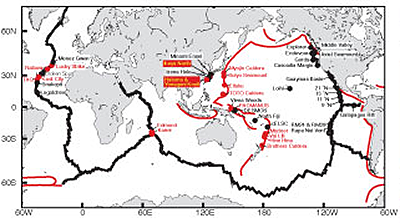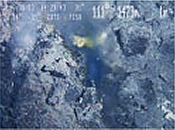Achievements
[1999年-2009年]
Elucidation of geological, geochemical and microbiological interaction in the global deep-sea hydrothermal systems
Since 1977, when the deep-sea hydrothermalism was discovered, it has been considered as one of the biggest 20th centuryfs discoveries in earth sciences. Many scientists have been attracted to this new research topic, as it also can be considered that life actually originated in those parts of the ancient Earth. However, the questions and mysteries have remained for more than thirty years since the discovery. Why are there most cosmopolitan and some regionally different microorganisms living at each active hydrothermal area? How do those microorganisms live in such extreme habitats around the active hydrothermal fields? JAMSTEC SUGAR Project has been investigating numerous active hydrothermal fields and their different habitats in a field in the Pacific, Atlantic, and Indian Ocean by showing the interdisciplinary and comprehensive research strategy and exploring skills. The outcomes of investigations conducted a potential general rule of geological, geochemical and microbiological interaction in the deep-sea hydrothermal systems, called gGeochemical control on deep-sea hydrothermal vent microbial communities by mean s of chemolithotrohic energy potentialsh. The key chemical factor is molecular hydrogen, not hydrogen sulfide and methane.

Distribution map of active hydrothermal fields investigated by JAMSTEC SUGAR Project. By comparing the hydrothermal vent microbial communities all over the world, it became clear that the microbial communities differ not due to the geographic locality, but geological settings. As a result, a hypothetical model of "geochemical control on deep-sea hydrothermal vent microbial communities by mean s of chemolithotrohic energy potentials " was proposed, which states that the each hydrothermal field's microbial productivity depends on the molecular hydrogen concentration.

Photos of the Okinawa Trough Yonaguni Knoll IV hydrothermal field. Under strange structure called gflangeh is the jet of hydrothermal fluid containing a large amount of carbon dioxide; looks like it is boiling. Grape-like structures of carbon dioxide, turned into lumps after being separated from hydrothermal fluid, for the exceptionally high concentration of carbon dioxide in the fluid. Carbon dioxide separated from hydrothermal fluid is accumulated into surrounding sediments, then creates liquid carbon dioxide pools.

Photo of the Mariner hydrothermal field discovered by JAMSTEC SUGAR Program in the south-west Pacific Ocean. Research was started at the same season with American research group; initially found by SUGAR.

Photos of gBlue Smokerh, the worldfs first-discovered gblue hydrothermal fluidh by SUGAR Project, JAMSTEC. Discovered in the Okinawa Trough Hatoma Knoll hydrothermal field. At first, it was much debated that the blue color was related to the magmatic activities; however, the later researches proved that it is due to the supercritical carbon dioxidefs optical phenomenon.
